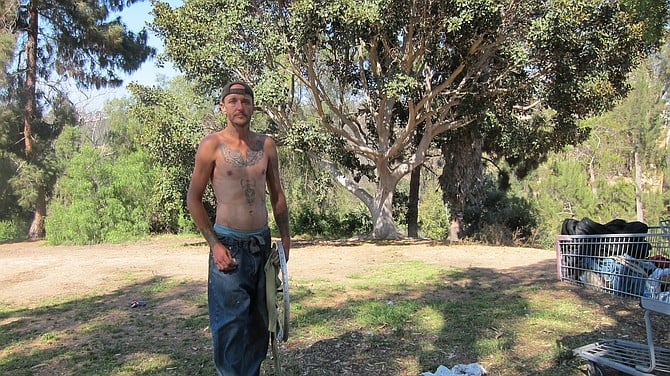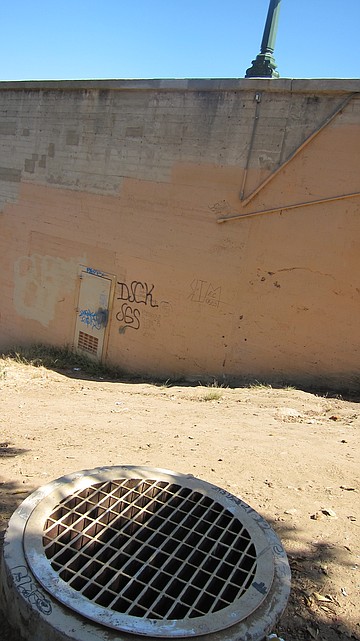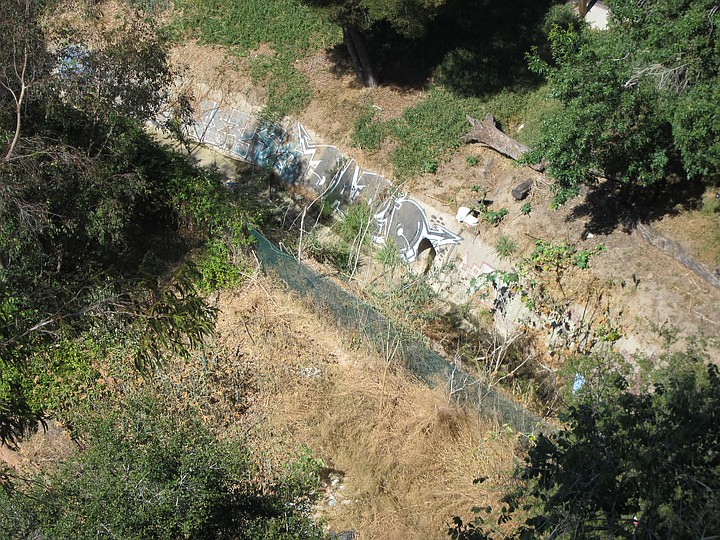 Facebook
Facebook
 X
X
 Instagram
Instagram
 TikTok
TikTok
 Youtube
Youtube

Back in 2007, it was reported that a group of transients was evicted from inside the columns of Cabrillo Bridge. A photograph featured in an article showed a makeshift apartment inside the bridge complete with wall and floor coverings, bedding, shelving, clothing rack, and tenant.
This week the Reader reported that transients had again gained entry to the bridge’s interior, this time via manholes and doors. I went to check out the manholes and doors in and around the bridge on July 21. When I arrived early that Friday afternoon, families, couples, joggers, cyclists, and vehicles were traversing the bridge. Looking over the side of the bridge, I saw a jogger in the canyon below as well as movement in what appeared to be a homeless camp under a large bush at the base of the bridge next to the freeway — complete with trash, graffiti, and clothing.

As I walked back toward Sixth Avenue, I saw what appeared to be two homeless men hugging each other goodbye. One went off toward Sixth Avenue, the other into the canyon.
When taking that same exit, to the left I saw an idyllic area with willowy pepper trees and a couple having a picnic. As I was taking photos, a shirtless man with a shopping cart appeared from the bridge. His cart had beer cans, a garment bag, a bicycle wheel, and other things.
I asked if he had seen anyone going into or out of the bridge. With a Southern drawl, he introduced himself as Nick and said that he had not seen anything. "And I'm around here most of the time — every day. I sleep down there in the canyon. If there is anyone living in there? I want to know. Is it scary in there? Is it dark? With my luck, I'd move in there and the big earthquake would happen."
I explained that others had seen people leaving and entering the bridge through the manholes. He said, "I thought there was doors into the bridge but they are locked. I wouldn't even go in them if they were unlocked."
Nick told me he was heading to San Francisco as soon as he can afford a Greyhound Bus ticket. He said he spent eight hours collecting aluminum cans the other day and ended up with $4.37. He has tried to get day-labor work while standing outside a Home Depot, but "the Mexicans told me I wasn't welcome. I was, like, ‘Well, how are you going to tell me…’ but the people grabbed them instead. I was, like, really? I'll work for just as cheap." Nick said he sometimes gets judged because of all his tattoos.

Originally from Mississippi, Nick said he used to work in a slaughterhouse. "I didn't kill the animals. I just helped herd them into where they were and then threw them on a table and someone else chopped them up."
Nick then told me he couldn't eat chicken anymore because they served it too often in jail. He said he was incarcerated for running moonshine.
Nick said he landed in San Diego when his grandfather passed away. His foster mother lives in San Francisco now and has a job lined up for him if he can get up there. He said his RV, dog, and motorcycle were stolen when he made a stop at Denny's on his way out of San Diego.
I asked if it was okay to take his photo for this article if I hid part of his face and he said, "I, I, I don't mind, I was on that TV show Lockup.”
Balboa Park's councilmember Chris Ward is on the homeless task force, which is focusing on how to help people like Nick. Their first meeting was held in June; the next meeting is scheduled for September 13.
Ward will likely be discussing his recent visit to a tiny homes village in Seattle. The tiny homes serve as temporary housing until permanent housing can be located.


Back in 2007, it was reported that a group of transients was evicted from inside the columns of Cabrillo Bridge. A photograph featured in an article showed a makeshift apartment inside the bridge complete with wall and floor coverings, bedding, shelving, clothing rack, and tenant.
This week the Reader reported that transients had again gained entry to the bridge’s interior, this time via manholes and doors. I went to check out the manholes and doors in and around the bridge on July 21. When I arrived early that Friday afternoon, families, couples, joggers, cyclists, and vehicles were traversing the bridge. Looking over the side of the bridge, I saw a jogger in the canyon below as well as movement in what appeared to be a homeless camp under a large bush at the base of the bridge next to the freeway — complete with trash, graffiti, and clothing.

As I walked back toward Sixth Avenue, I saw what appeared to be two homeless men hugging each other goodbye. One went off toward Sixth Avenue, the other into the canyon.
When taking that same exit, to the left I saw an idyllic area with willowy pepper trees and a couple having a picnic. As I was taking photos, a shirtless man with a shopping cart appeared from the bridge. His cart had beer cans, a garment bag, a bicycle wheel, and other things.
I asked if he had seen anyone going into or out of the bridge. With a Southern drawl, he introduced himself as Nick and said that he had not seen anything. "And I'm around here most of the time — every day. I sleep down there in the canyon. If there is anyone living in there? I want to know. Is it scary in there? Is it dark? With my luck, I'd move in there and the big earthquake would happen."
I explained that others had seen people leaving and entering the bridge through the manholes. He said, "I thought there was doors into the bridge but they are locked. I wouldn't even go in them if they were unlocked."
Nick told me he was heading to San Francisco as soon as he can afford a Greyhound Bus ticket. He said he spent eight hours collecting aluminum cans the other day and ended up with $4.37. He has tried to get day-labor work while standing outside a Home Depot, but "the Mexicans told me I wasn't welcome. I was, like, ‘Well, how are you going to tell me…’ but the people grabbed them instead. I was, like, really? I'll work for just as cheap." Nick said he sometimes gets judged because of all his tattoos.

Originally from Mississippi, Nick said he used to work in a slaughterhouse. "I didn't kill the animals. I just helped herd them into where they were and then threw them on a table and someone else chopped them up."
Nick then told me he couldn't eat chicken anymore because they served it too often in jail. He said he was incarcerated for running moonshine.
Nick said he landed in San Diego when his grandfather passed away. His foster mother lives in San Francisco now and has a job lined up for him if he can get up there. He said his RV, dog, and motorcycle were stolen when he made a stop at Denny's on his way out of San Diego.
I asked if it was okay to take his photo for this article if I hid part of his face and he said, "I, I, I don't mind, I was on that TV show Lockup.”
Balboa Park's councilmember Chris Ward is on the homeless task force, which is focusing on how to help people like Nick. Their first meeting was held in June; the next meeting is scheduled for September 13.
Ward will likely be discussing his recent visit to a tiny homes village in Seattle. The tiny homes serve as temporary housing until permanent housing can be located.
Comments